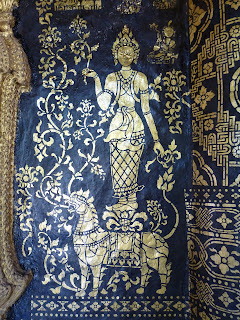On my last day in Laos, I visited two more of Luang Prabang's famous sights. The first one was Wat Xieng Thong, one of the most important monasteries in Laos. The weather was perfect, and in the bright sunlight the temple with its tiered roof looked especially resplendent.
Inside was a huge golden Buddha along with many smaller ones - the standard interior of many Buddhist temples.
What made this one special were the graceful golden decorations that were painted all over the interior and exterior walls:
The temple's rear wall was painted red and decorated with a huge mosaic tree. Since the temple's name allegedly means something like "golden tree temple," this decoration may well be the reason for the name.
Many of the smaller buildings next to the main prayer hall were also richly decorated, mostly with scenes depicting Lao life (and probably Lao myth and stories as well). This picture shows just a small portion of one building's wall - just imagine how many stories can be told with this kind of decoration if you have the walls of several big temple buildings!
The second place I visited was the ethnographic museum. They had explanations about the different peoples that live in Laos, and displayed many of their traditional dresses. This, for example, is the dress, headdress and jewelry that Akha women traditionally wear:
The museum also explained the marriage customs in Laos. In general, marriages between persons from different peoples are accepted and widely practiced. Some of the peoples have rules that forbid their members to marry within their family, or even within their village. As a consequence, festivals such as the new year celebration and occasions like the end of the harvest are used to meet people (i.e. potential partners) from other villages. According to the museum, marriages in Laos are almost never arranged - an interesting difference to Vietnam, where the practice of arranging marriages seems to be somewhat more common, at least among some of the hill tribes.





